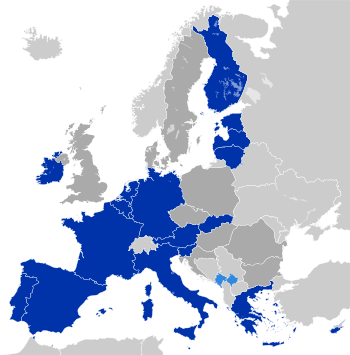Military of the European Union
| Military of the European Union | |
|---|---|
|
| |
|
| |
| Organisations |
|
| Equipment | 546 ships, 2,448 aircraft & 7,490 battle tanks |
| Manpower | |
| Active personnel | 1,825,000 (2016)[1] |
| Expenditures | |
| Budget | $226.73 billion (2016)[1] |
| Percent of GDP | 1.42% (2014)[1] |
| European Union |
 This article is part of a series on the |
Policies and issues
|
The military of the European Union comprises the various cooperative structures that have been established between the armed forces of the member states, both intergovernmentally and within the institutional framework of the union; the Common Security and Defence Policy (CSDP) branch of the Common Foreign and Security Policy (CFSP).
The policy area of defence is principally the domain of nation states. The main military alliance in Europe remains the intergovernmental North Atlantic Treaty Organisation (NATO), which presently includes 22 EU member states together with four non-EU European countries, Albania, Iceland, Turkey and Norway, as well as the United States and Canada. The development of the CSDP with regard to the existing role of NATO is a contentious issue. The military form of European integration has however intensified in the beginning of the 21st century, bringing about the deployment of numerous CSDP operations and the establishment of EU battlegroups. The latter have however never been engaged in operations, and other, recent examples of military integration, such as the European corps, gendarmerie force and air transport command, are intergovernmental, and outside the institutional framework of the union.
Article 42 of the Treaty on European Union provides for substantial military integration within the institutional framework of the union.[2] Complete integration is an option that requires unanimity in the European Council of heads of state or government. For now it remains politically gridlocked considering the critical stance of the United Kingdom in particular. Article 42 does also provide for a permanent structured cooperation between the armed forces of a subset of member states. As of 2015 this option has not been used, despite calls by prominent leaders such as former French President Nicolas Sarkozy, German Chancellor Angela Merkel, former Italian Foreign Minister Franco Frattini and former Belgian Prime Minister Guy Verhofstadt for a common defence for the Union.[3][4][5] However the debate has intensified by the standoff between the EU and Russia over Ukraine. With new calls for an EU military by EU commission president Jean-Claude Juncker and by other European leaders and policy makers like the head of the German parliament’s foreign policy committee Norbert Röttgen, saying an EU army was “a European vision whose time has come”.[6][7] Article 42 was invoked for the first time by French President François Hollande, following the November 2015 Paris attacks. Speaking in front of a joint session of parliament in Versailles, Hollande described the terrorist attack as an attack against Europe as a whole.[8][9]
History

Following the end of World War II and the defeat of the Axis Powers, the Dunkirk Treaty was signed by France and the United Kingdom on 4 March 1947 as a Treaty of Alliance and Mutual Assistance against a possible German attack in the aftermath of World War II. The Dunkirk Treaty entered into force on 8 September 1947. The 1948 Treaty of Brussels established the military Western Union Defence Organisation with an allied European command structure under Field Marshal Montgomery. Western European powers, except for Ireland, Sweden, Finland and Austria, signed the North Atlantic Treaty alongside the United States and Canada which only created a passive defence association until 1951 when, during the Korean War, the existing and fully functioning Western Union Defence Organisation was augmented to form the North Atlantic Treaty Organisation, NATO.
Western European Union
In the early 1950s, France, Germany, Italy and the Benelux countries made an attempt to integrate the militaries of mainland western Europe, through the treaty establishing the European Defence Community (EDC). This scheme did not enter into force, however, as it failed to obtain approval for ratification in the French National Assembly, where Gaullists feared for national sovereignty and Communists opposed a European military consolidation that could rival the Soviet Union. The failure to establish the EDC resulted in the 1954 amendment of the Treaty of Brussels at the London and Paris Conferences which, in replacement of EDC, established the political Western European Union (WEU) out of the earlier established military Western Union Defence Organisation and included West Germany and Italy in both WEU and NATO as the conference ended the occupation of West Germany and the defence aims had shifted from Germany to the Soviet Union.
Common Security and Defence Policy
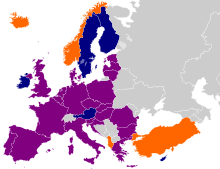
Out of the 28 EU member states, 22 are also members of NATO. Another two NATO members are EU applicants—Albania and Turkey. Two others—Iceland and Norway—have opted to remain outside of the EU, however participate in the EU's single market. In 1996, the Western European Union (WEU) was tasked by NATO to implement a European Security and Defence Identity within NATO, which later was passed over to the EU Common Security and Defence Policy as all Western European Union functions were transferred to the European Union through the Lisbon Treaty. The memberships of the EU and NATO are distinct, and some EU member states are traditionally neutral on defence issues. Several of the new EU member states were formerly members of the Warsaw Pact. The Berlin Plus agreement is a comprehensive package of agreements made between NATO and the EU in 2002; it allows the EU to draw on some of NATO's assets in its own peacekeeping operations, subject to a "right of first refusal" in that NATO must first decline to intervene in a given crisis.
Following the Kosovo War in 1999, the European Council agreed that "the Union must have the capacity for autonomous action, backed by credible military forces, the means to decide to use them, and the readiness to do so, in order to respond to international crises without prejudice to actions by NATO". To that end, a number of efforts were made to increase the EU's military capability, notably the Helsinki Headline Goal process. After much discussion, the most concrete result was the EU Battlegroups initiative, each of which is planned to be able to deploy quickly about 1500 personnel.[10]
The EU currently has a limited mandate over defence issues, with a role to explore the issue of European defence agreed to in the Amsterdam Treaty, as well as oversight of the Helsinki Headline Goal Force Catalogue (the 'European Rapid Reaction Force') processes. However, some EU states may and do make multilateral agreements about defence issues outside of the EU structures.
Initiative of the four
The European Defence Initiative is a proposal for enhanced European Union defence cooperation presented by France, Germany, Belgium and Luxembourg in Brussels on 29 April 2003. It was based on the reinforced cooperation principle and aimed for better reactivity under the European Security and Defence Policy (ESDP).
Some critics felt that this intra-European process would be a source of tension in the transatlantic arena with NATO and some felt that this was a duplication of existing means with the call for a distinct European headquarters. There were also some concerns about a multi-speed Europe. Britain was initially opposed to the concept but subsequently modified its position in favour.[11]
It is sometimes referred to as the "Initiative of the Four".
SAFE
On 20 February 2009 the European Parliament voted in favour of the creation of Synchronised Armed Forces Europe (SAFE) as a first step towards a true European military force. SAFE will be directed by an EU directorate, with its own training standards and operational doctrine. There are also plans to create an EU "Council of Defence Ministers" and "a European statute for soldiers within the framework of Safe governing training standards, operational doctrine and freedom of operational action".[12] EU forces have been deployed on peacekeeping missions from middle and northern Africa to Western Balkans and western Asia.[13] EU military operations are supported by a number of bodies, including the European Defence Agency, European Union Satellite Centre and the European Union Military Staff.[14] In an EU consisting of 28 members, substantial security and defence co-operation is increasingly relying on great power co-operation.[15]
The entry into force of the Treaty of Lisbon triggered member states of the Western European Union (WEU) to scrap the organisation, which had largely become dormant, but they have kept the mutual defence clause of the Treaty of Brussels as the basis for the EU mutual defence arrangement.
Common Security and Defence Policy

The defence arrangements which have been established under the EU institutions are part of the Common Security and Defence Policy (CSDP), a branch of the Common Foreign and Security Policy (CFSP). It should be noted that Denmark has an opt-out from the CSDP.[1]
Security strategy
The European Security Strategy is the document in which the European Union clarifies its security strategy which is aimed at achieving a secure Europe in a better world, identifying the threats facing the Union, defining its strategic objectives and setting out the political implications for Europe.[16] The European security strategy was for the first time drawn up in 2003 under the authority of the EU's High Representative for the Common Foreign and Security Policy, Javier Solana, and adopted by the Brussels European Council of 12 and 13 December 2003.
Defence Agency
The European Defence Agency (EDA) is an agency of the union based in Brussels. Set up on 12 July 2004, it is a Common Foreign and Security Policy (CFSP) body reporting to the Council of the European Union. Its primary role is to foster European defence cooperation.
Military Committee and Staff
The European Union Military Staff (EUMS) is the body of the European External Action Service (EEAS) led by a Director General a General Officer, Admiral, or Air Officer of three-star level that supervises operations carried out by the union. The EUMS is overseen by the European Union Military Committee (EUMC). The EUMC is chaired by a General Officer, Admiral, or Air Officer of four-star level.
Institute for Security Studies
The European Union Institute for Security Studies (EUISS) is a Paris-based agency of the European Union. The EUISS evolved from Western European Union Institute for Security Studies following a gradual transfer of powers from the Western European Union (WEU) to the EU. It now operates under the Union's Common Foreign and Security Policy (CFSP).
The EUISS is an autonomous agency with full intellectual freedom. As a think tank it researches security issues of relevance for the EU and provides a forum for debate. In its capacity as an EU agency, it also offers analyses and forecasting to the High Representative for Foreign Affairs and Security Policy, Federica Mogherini.
Battle groups
.jpg)
The battle groups adhere to the CSDP, and are based on contributions from a coalition of member states. Each of the eighteen Battlegroups consists of a battalion-sized force (1,500 troops) reinforced with combat support elements.[17][18] The groups rotate actively, so that two are ready for deployment at all times. The forces are under the direct control of the Council of the European Union.
The Battlegroups reached full operational capacity on 1 January 2007, although, as of January 2013 they are yet to see any military action.[19] They are based on existing ad hoc missions that the European Union (EU) has undertaken and has been described by some as a new "standing army" for Europe.[18] The troops and equipment are drawn from the EU member states under a "lead nation". In 2004, United Nations Secretary-General Kofi Annan welcomed the plans and emphasised the value and importance of the Battlegroups in helping the UN deal with troublespots.[20]
Security and Defence College
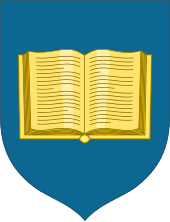
The European Security and Defence College (ESDC) is a virtual institution for strategic level training within the area of Common Security and Defence Policy (CSDP). ESDC was created in 2005 by a decision of the Council of the European Union,[21] and takes the form of a network of various national institutions of the European Union member states, such as defence colleges, and the European Union Institute for Security Studies.[22]
Helsinki Headline Goal
The Helsinki Headline Goal Catalogue is a listing of rapid reaction forces composed of 60,000 troops managed by the European Union, but under control of the countries who deliver troops for it.
Development that is provided for
Common defence
The Treaty of Lisbon introduced the following in the founding treaties of the union:
| “ | The common security and defence policy shall include the progressive framing of the common defence policy. This will lead to a common defence, when the European Council, acting unanimously, so decides. (TEU, Article 42)[23] | ” |
Permanent structured co-operation
.jpg)
The Treaty of Lisbon added the possibility for those members whose military capabilities fulfill higher criteria and which have made more binding commitments to one another in this area with a view to the most demanding missions shall establish permanent structured cooperation within the EU framework (PSCD).[24]
Those states shall notify their intention to the Council and to the High Representative. The Council then adopts, by qualified majority a decision establishing permanent structured cooperation and determining the list of participating Member States. Any other member state, that fulfills the criteria and wishes to participate, can join the PSCD following the same procedure, but in the voting for the decision will participate only the states already part of the PSCD. If a participating state no longer fulfills the criteria a decision suspending its participation is taken by the same procedure as for accepting new participants, but excluding the concerned state from the voting procedure. If a participating state wishes to withdraw from PSCD it just notifies the Council to remove it from the list of participants. All other decisions and recommendations of the Council concerning PSCD issues unrelated to the list of participants are taken by unanimity of the participating states.[24]
The criteria established in the PSCD Protocol are the following:[24]
- co-operate and harmonise requirements and pool resources in the fields related to defence equipment acquisition, research, funding and utilisation, notably the programmes and initiatives of the European Defence Agency (e.g. Code of Conduct on Defence Procurement)
- capacity to supply, either at national level or as a component of multinational force groups, targeted combat units for the missions planned, structured at a tactical level as a battle group, with support elements including transport (airlift, sealift) and logistics, within a period of five to 30 days, in particular in response to requests from the United Nations, and which can be sustained for an initial period of 30 days and be extended up to at least 120 days.
- capable of carrying out in the above timeframes the tasks of joint disarmament operations, humanitarian and rescue tasks, military advice and assistance tasks, conflict prevention and peace-keeping tasks, tasks of combat forces in crisis management, including peace-making and post-conflict stabilisation[24]
As of October 2010 there is no announcement for PSCD establishment.
Intergovernmental cooperation
This section presents an incomplete list of forces and bodies established intergovernmentally outside the legal framework of the union amongst a subset of member states. The military forces that have been established are typically dedicated in priority to the European Union (EU), but may also be deployed either in a NATO environment, acting as part of the European branch of NATO, acting upon the mandate of the participating countries, or acting upon the mandate of other international organisations, such as United Nations, the Organization for Security and Co-operation in Europe, or any other international entity.
Terrestrial
Finabel
Finabel is an organisation that promotes cooperation and interoperability between the armies of its participating nations.[25] Founded in 1953, Finabel has a small permanent secretariat, and is controlled by the army chiefs of staff of its participating nations. The organisation maintains working groups that publish studies relating to standardisation of equipment, procedures, testing methods and glossaries.
Corps
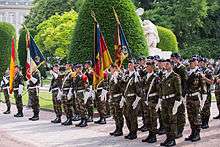
The European Corps, often shortened as Eurocorps, is an army corps of approximately 1,000 soldiers stationed in Strasbourg, France. Based in the French city of Strasbourg, the corps had its headquarters established in May 1992, activated in October 1993 and declared operational in 1995. The nucleus of the force is the Franco-German Brigade, established in 1987.[26]
I. German/Dutch Corps
_Corps.svg.png)
I. German/Dutch Corps is a multinational formation consisting of units from the Dutch and German armies. The corps headquarters also takes part in NATO Response Force readiness rotations. The Corps' headquarters are situated in Münster (Westphalia), formerly the headquarters of the German Army's I. Corps out of which 1 German/Netherlands Corps evolved. The corps has national and multinational operational responsibilities, and its commanding officer is the only one in Europe to have OPCON in peacetime.[27] Due to its role as a NATO High Readiness Forces Headquarters, soldiers from other NATO member states, the United States, Denmark, Norway, Spain, Italy, the United Kingdom amongst others, are also stationed at Münster.
Multinational Corps Northeast
.svg.png)
The Multinational Corps Northeast was formed on 18 September 1999 at Szczecin, Poland, which became its headquarters. It evolved from what was for many years the only multinational corps in NATO, Allied Land Forces Schleswig-Holstein and Jutland (LANDJUT) (in its turn, a part of Allied Forces Northern Europe). From 1962 LANDJUT had been responsible for the defence of the Baltic Approaches from a headquarters at Rendsburg, Germany. It comprised the 6th Panzergrenadier Division and the Danish Jutland Division.
Gendarmerie Force
The European Gendarmerie Force (EUROGENDFOR or EGF) is an intervention force with militarised police functions and specialisation in crisis management, designed after the French Gendarmerie, the Spanish Guardia Civil, and the Italian Carabinieri and its Multinational Specialized Units (M.S.U.).[28][29] The force was created in 2006, and had its status enshrined in the Treaty of Velsen, signed 18 October 2007.[30]
Aerial
Air Group
The European Air Group (EAG) an organisation that promotes cooperation and interoperability between the air forces of its participating nations. It was established in 1995 to promote collaboration between the British and French air forces in the first Gulf War and the subsequent Balkans operations.
Air Transport Command

The European Air Transport Command (EATC) is the command centre that exercises the operational control of the majority of the aerial refueling capabilities and military transport fleets of its participating nations. Located at Eindhoven Airbase in the Netherlands, the command also bears a limited responsibility for exercises, aircrew training and the harmonisation of relevant national air transport regulations.[32][33]
The command was established in 2010 with a view to provide a more efficient management of the participating nations' assets and resources in this field.
Naval
Maritime Force
The European Maritime Force (Euromarfor or EMF) is a non-standing,[34] military force[35] that may carry out naval, air and amphibious operations, with an activation time of 5 days after an order is received.[36] The force was formed in 1995 to fulfill missions defined in the Petersberg Declaration, such as sea control, humanitarian missions, peacekeeping operations, crisis response operations, and peace enforcement.
Multi-component
Movement Coordination Centre
Movement Coordination Centre Europe (MCCE) is an organisation located at Eindhoven Airport in the Netherlands that aims to coordinate and optimise the use of airlift, sealift and land movement assets owned or leased by its participating nations. Established on 1 July 2007 when the earlier European Airlift Centre (EAC) and the Sealift Co-ordination Centre (SCC) merged, the MCCE was a response to the shortage of aerial and naval strategic lift capabilities reported by the EU and NATO in 1999. The centre is presently staffed by 30 military and civilians personnel from its participating nations. In addition to its EU members, the United States and Turkey participate in the MCCE.
Organisation for Joint Armament Cooperation
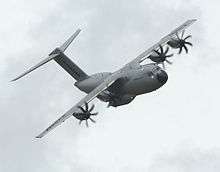
The Organisation for Joint Armament Cooperation (shortened OCCAR; the French acronym) is an organisation that facilitates and manages collaborative armament programmes through their lifecycle between its participating nations.
Combined Joint Expeditionary Force
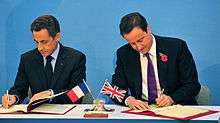
The Combined Joint Expeditionary Force (CJEF) is a Franco-British military force. It draws upon both the British Armed Forces and the French Armed Forces to field a deployable force with land, air and maritime components together with command and control and supporting logistics. It is distinct from the similarly named UK Joint Expeditionary Force.
The Combined Joint Expeditionary Force (or CJEF) is envisaged as a deployable, combined Franco-British military force for use in a wide range of crisis scenarios, up to and including high intensity combat operations. As a joint force it involves all three armed Services: a land component composed of formations at national brigade level, maritime and air components with their associated Headquarters, together with logistics and support functions.
The CJEF is not conceived as a standing force but rather as available at notice for UK-French bilateral, NATO, European Union, United Nations or other operations. Combined air and land exercises commenced during 2011 with a view towards developing a full capability. The CJEF is also seen as a potential stimulus towards greater interoperability and coherence in military doctrine, training and equipment requirements.
Membership
| Finabel | European Corps | European Gendarmerie Force | European Air Transport Command | European Air Group | European Maritime Force | Movement Coordination Centre Europe[lower-alpha 1] | Organisation for Joint Armament Cooperation | |
|---|---|---|---|---|---|---|---|---|
| Abbreviation | None | Eurocorps | EUROGENDFOR, EGF | EATC | EAG | EUROMARFOR, EMF | MCCE | OCCAR |
| Arms |  |
 |
 |
 |
 |
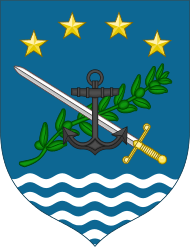 |
 |
None |
| Branch | Terrestrial | Aerial | Naval | Multi-component | ||||
| Description | Organisation promoting interoperability | Corps | Gendarmerie | Command for refueling and transport capabilities | Organisation promoting interoperability | Non-standing force | Control centre for movement | Organisation facilitating armament programmes |
| Founded | 1953 | 1992 | 2006 | 2010 | 1995 | 1995 | 2007 | 1996 |
| Seat | Brussels | Strasbourg | Vicenza | Eindhoven | Buckinghamshire | N/A | Eindhoven | Bonn |
| Capacity | N/A | 60 000 troops | 2 300 troops | 220 aircraft | N/A | N/A | N/A | N/A |
| Response time | N/A | 30 days | 30 days | N/A | N/A | 5 days | N/A | N/A |
| Motto | Reflexion serving military action | None | Lex paciferat | Integrated, innovative, efficient | Improved capability through interoperability | At sea for peace | None | None |
| Working language | Unknown | English | Unknown | English | Unknown | Unknown | Unknown | Unknown |
| Membership (year of accession) | ||||||||
| |
No | No | N/A | No | No | N/A | 2010 | No |
| |
1953 | 1993 | N/A | 2010 | 1997 | No | 2007 | 2003 |
| |
No | No | No | No | No | No | No | No |
| |
2008 | No | N/A | No | No | No | No | No |
| |
No | No | N/A | No | No | No | 2011 | No |
| |
2012 | No | N/A | No | No | N/A | 2010 | No |
| |
No | No | N/A | No | No | No | 2007 | No |
| |
No | No | N/A | No | No | No | 2007 | No |
| |
2008 | No | N/A | No | No | No | 2007 | No |
| |
1953 | 1992 | 2006 | 2010 | 1995 | 1995 | 2007 | 1996 |
| |
1956 | 1992 | N/A | 2010 | 1997 | No | 2007 | 1996 |
| |
1996 | No | N/A | No | No | No | No | No |
| |
2015 | No | No | No | No | N/A | 2007 | No |
| |
No | No | N/A | No | No | No | No | No |
| |
1953 | No | 2006 | 2015 | 1997 | 1995 | 2007 | 1996 |
| |
2016 | No | N/A | No | No | No | 2007 | No |
| |
No | No | Partner | No | No | No | 2015 | No |
| |
1953 | 1996 | N/A | 2012 | No | N/A | 2007 | No |
| |
2010 | No | N/A | No | No | No | No | No |
| |
1953 | No | 2006 | 2010 | 1997 | No | 2007 | No |
| |
2006 | 2017 | 2011 | No | No | No | 2008 | No |
| |
1996 | No | 2006 | No | No | 1995 | 2010 | No |
| |
2008 | No | 2009 | No | No | No | 2008 | No |
| |
2006 | No | N/A | No | No | N/A | 2015 | No |
| |
2016 | No | N/A | No | No | No | 2007 | No |
| |
1990 | 1994 | 2006 | 2014 | 1997 | 1995 | 2007 | 2005 |
| |
2015 | No | N/A | No | No | No | 2007 | No |
| |
1973 | No | N/A | No | 1995 | No | 2007 | 1996 |
National militaries
Six EU states host nuclear weapons: France and the United Kingdom each have their own nuclear programmes, while Belgium, Germany, Italy and the Netherlands host US nuclear weapons as part of NATO's nuclear sharing policy. Combined, the EU possesses 525 warheads, and hosts between 90 and 130 US warheads. The EU has the third largest arsenal of nuclear weapons, after the United States and Russia.
Expenditure and personnel
The following table presents the military expenditures of the members of the European Union in euros (€). The combined military expenditure of the member states amounts to just over €194,7 billion.[1] This represents 1.42% of European Union GDP.[1] European military expenditure includes spending on joint projects such as the Eurofighter Typhoon and joint procurement of equipment. The European Union's combined active military forces in 2014 totaled 1,423,097 personnel. According to the European Defence Agency, the European Union had an average of 31,570 land force personnel deployed around the world (or 2.2% of the total military personnel). In a major operation the EU could readily deploy up-to 417,180 land force personnel and sustain 79,352 of those during an enduring operation.[1]
In a speech in 2012, Swedish General Håkan Syrén criticised the spending levels of European Union countries, saying that in the future those countries' military capability will decrease, creating "critical shortfalls".[37]
Guide to table:
- All figure entries in the table below are provided by the European Defence Agency for the year 2014. Figures from other sources are not included.
| Member state | Expenditure (€ mn.) | Per capita (€) | % of GDP | Military personnel (active) | Deployable land forces |
|---|---|---|---|---|---|
| | 194,782 | 387 | 1.42 | 1,423,097 | 417,180 |
| 2,491 | 292 | 0.76 | 22,689 | 2,234 | |
| 3,913 | 351 | 0.97 | 30,174 | 6,691 | |
| 563 | 78 | 1.34 | 25,188 | 6,380 | |
| 606 | 143 | 1.41 | 15,380 | 2,098 | |
| 270 | 315 | 1.54 | 11,747 | 237 | |
| 1,493 | 142 | 0.96 | 20,222 | 7,867 | |
| 386 | 294 | 1.98 | 6,285 | 483 | |
| 2,714 | 497 | 1.33 | 8,275 | 1,738 | |
| 39,198 | 592 | 1.83 | 207,000 | 63,350 | |
| 34,749 | 422 | 1.20 | 178,800 | ||
| 4,001 | 364 | 2.23 | 113,517 | 21,500 | |
| 912 | 92 | 0.88 | 22,667 | 3,714 | |
| 893 | 193 | 0.48 | 9,280 | 850 | |
| 18,427 | 303 | 1.14 | 183,465 | ||
| 223 | 112 | 0.93 | 4,646 | 1,242 | |
| 322 | 110 | 0.89 | 8,568 | ||
| 190 | 341 | 0.54 | 821 | 242 | |
| 43 | 100 | 0.54 | 1,662 | 105 | |
| 7,788 | 462 | 1.19 | 42,102 | 14,685 | |
| 7,565 | 197 | 1.83 | 99,500 | 1,464 | |
| 2,501 | 241 | 1.45 | 30,302 | 7,878 | |
| 2,029 | 102 | 1.35 | 69,556 | 9,605 | |
| 749 | 138 | 1.00 | 13,338 | 4,602 | |
| 366 | 178 | 0.98 | 6,765 | 3,000 | |
| 9,508 | 205 | 0.90 | 121,848 | 43,812 | |
| 4,711 | 486 | 1.10 | 15,570 | 2,818 | |
| 48,172 | 747 | 2.17 | 153,730 | 69,808 |
Naval forces
_underway_2009.jpg)
The combined component strength of the naval forces of member states is some 563 commissioned warships. Of those in service, 3 are fleet carriers, the largest of which is the 42,000 tonne Charles de Gaulle. However two 70,600 tonne Queen Elizabeth-class carriers are projected to enter service in the Royal Navy starting 2017. The EU also has 5 amphibious assault ships and 13 amphibious support ships in service. Of the EU's 58 submarines, 21 are nuclear-powered submarines (11 British and 10 French) while 37 are conventional attack submarines.
Operation Atalanta (formally European Union Naval Force Somalia) is the first ever (and still ongoing) naval operation of the European Union. It is part of a larger global action by the EU in the Horn of Africa to deal with the Somali crisis. As of January 2011 twenty-three EU nations participate in the operation.
Britain and France have blue-water navies while Italy, Spain and the Netherlands have green-water navies.
Guide to table:
- Ceremonial vessels, research vessels, supply vessels, training vessels, and icebreakers are not included.
- The table only counts warships that are commissioned (or equivalent) and active.
- Surface vessels displacing less than 200 tonnes are not included, regardless of other characteristics.
- The "amphibious support ship" category includes amphibious transport docks and dock landing ships, and tank landing ships.
- Frigates over 6,000 tonnes are classified as destroyers.
- The "patrol vessel" category includes missile boats.
- The "anti-mine ship" category includes mine countermeasures vessels, minesweepers and minehunters.
- Generally, total tonnage of ships is more important than total number of ships, as it gives a better indication of capability.
| Member state | Fleet carrier | Amphibious assault ship | Amphibious support ship | Destroyer | Frigate | Corvette | Patrol vessel | Anti‑mine ship | Missile sub. | Attack sub. | Total | Tonnage |
|---|---|---|---|---|---|---|---|---|---|---|---|---|
| 3 | 5 | 25 | 31 | 93 | 48 | 123 | 152 | 8 | 50 | ~500 | ~1,500,000 | |
| 0 | 0 | |||||||||||
| 2 | 2 | 5 | 9 | 10,009 | ||||||||
| 1 | 4 | 3 | 1 | 10 | 18 | 15,160 | ||||||
| 5 | 2 | 7 | 2,869 | |||||||||
| 0 | 0 | |||||||||||
| 0 | 0 | |||||||||||
| 5 | 4 | 9 | 18 | 51,235 | ||||||||
| 3 | 3 | 2,000 | ||||||||||
| 4 | 4 | 12 | 20 | 5,429 | ||||||||
| 1 | 3 | 2 | 10 | 11 | 20 | 18 | 4 | 6 | 78 | 319,195 | ||
| 3 | 7 | 5 | 8 | 15 | 4 | 44 | 82,790 | |||||
| 5 | 13 | 26 | 4 | 8 | 51 | 137,205 | ||||||
| 0 | 0 | |||||||||||
| 8 | 8 | 12,133 | ||||||||||
| 2 | 3 | 4 | 13 | 5 | 10 | 10 | 6 | 55 | 184,744 | |||
| 5 | 5 | 3,025 | ||||||||||
| 4 | 4 | 8 | 5,678 | |||||||||
| 0 | 0 | |||||||||||
| 2 | 2 | 1,419 | ||||||||||
| 2 | 4 | 2 | 4 | 6 | 4 | 22 | 116,308 | |||||
| 5 | 2 | 1 | 3 | 19 | 5 | 28 | 19,724 | |||||
| 5 | 7 | 7 | 2 | 23 | 34,686 | |||||||
| 3 | 7 | 6 | 5 | 21 | 23,090 | |||||||
| 0 | 0 | |||||||||||
| 2 | 2 | 900 | ||||||||||
| 1 | 2 | 5 | 6 | 18 | 7 | 3 | 42 | 148,607 | ||||
| 6 | 11 | 5 | 22 | 14,256 | ||||||||
| 1 | 5 | 6 | 13 | 4 | 15 | 4 | 7 | 75 | 367,850 |
Land forces

Combined, the member states of the European Union maintain large numbers of various land-based military vehicles and weaponry.
Guide to table:
- The table is not exhaustive and only includes land forces equipment of EU-NATO member countries under the Conventional Armed Forces in Europe Treaty (CFE treaty).
- The CFE treaty only includes equipment geographically stationed within Europe. Equipment overseas on operations are not counted.
- The "main battle tank" category also includes tank destroyers (such as the Italian B1 Centauro) or any self-propelled armoured fighting vehicle, capable of heavy firepower. According to the CFE treaty.
- The "armoured fighting vehicle" category includes any armoured vehicle primarily designed to transport infantry and equipped with an automatic cannon of at least 20 mm calibre. According to the CFE treaty.
- The "artillery" category includes self-propelled or towed howitzers and mortars of 100 mm calibre and above. Other types of artillery are not included regardless of characteristics. According to the CFE treaty.
- The "attack helicopter" category includes any rotary wing aircraft armed and equipped to engage targets or equipped to perform other military functions (such as the Apache or the Wildcat). According to the CFE treaty.
| Member state | Main battle tank | Armoured fighting vehicle | Artillery | Attack helicopter |
|---|---|---|---|---|
| 7,490 | 17,688 | 8,936 | 788 | |
| 32 | 152 | 113 | 26 | |
| 314 | 556 | 950 | 12 | |
| 123 | 440 | 179 | 17 | |
| 56 | 249 | 31 | 12 | |
| 140 | 196 | 732 | ||
| 484 | 3,130 | 505 | 232 | |
| 816 | 1,485 | 345 | 72 | |
| 1,621 | 2,254 | 1,890 | 29 | |
| 74 | 575 | 30 | 18 | |
| 1,168 | 2,340 | 1,086 | 94 | |
| 114 | 500 | 131 | 16 | |
| 984 | 1,691 | 852 | 87 | |
| 220 | 407 | 374 | ||
| 725 | 1,304 | 1,286 | 22 | |
| 30 | 315 | 67 | ||
| 476 | 1,046 | 829 | 31 | |
| 253 | 1,244 | 268 | 120 |
Air forces

The air forces of EU member states operate a wide range of military systems and hardware. This is primarily due to the independent requirements of each member state and also the national defence industries of some member states. However such programmes like the Eurofighter Typhoon and Eurocopter Tiger have seen many European nations design, build and operate a single weapons platform. 60% of overall combat fleet was developed and manufactured by member states, 32% are US-origin, but some of these were assembled in Europe, while remaining 8% are soviet-made aircraft. As of 2014, it is estimated that the European Union had around 2,000 serviceable combat aircraft (fighter aircraft and ground-attack aircraft).[56]
The EUs air-lift capabilities are evolving with the future introduction of the Airbus A400M (another example of EU defence cooperation). The A400M is a tactical airlifter with strategic capabilities.[57] Around 140 are initially expected to be operated by 6 member states (UK, Luxembourg, France, Germany, Spain and Belgium).
Guide to tables:
- The tables are sourced from figures provided by Flight International for the year 2014.
- Aircraft are grouped into three main types (indicated by colors): red for combat aircraft, green for aerial refueling aircraft, and grey for strategic and tactical transport aircraft.
- The two "other" columns include additional aircraft according to their type sorted by colour (i.e. the "other" category in red includes combat aircraft, while the "other" category in grey includes both aerial refueling and transport aircraft). This was done because it was not feasible allocate every aircraft type its own column.
- Other aircraft such as trainers, helicopters, UAVs and reconnaissance or surveillance aircraft are not included in the below tables or figures.
- Fighter and ground-attack
| Member state | Typhoon | Rafale | Mirage 2000 | Gripen | F-16 | F/A-18 | F-35 | Tornado | Harrier II | MiG-29 | Other | Total |
|---|---|---|---|---|---|---|---|---|---|---|---|---|
| 423 | 131 | 137 | 232 | 463 | 148 | 7 | 278 | 33 | 58 | 176 | 2,086 | |
| 15 | 15 | |||||||||||
| 59 | 59 | |||||||||||
| 15 | 15 | |||||||||||
| 12 MiG-21 | 12 | |||||||||||
| 0 | ||||||||||||
| 14 | 19 L-159 | 31 | ||||||||||
| 60 | 60 | |||||||||||
| 0 | ||||||||||||
| 62 | 62 | |||||||||||
| 131 | 94 | 17 Super Étendard | 242 | |||||||||
| 117 | 116 | 233 | ||||||||||
| 43 | 166 | 46 F-4 | 255 | |||||||||
| 14 | 14 | |||||||||||
| 0 | ||||||||||||
| 80 | 1 | 75 | 16 | 55 AMX | 227 | |||||||
| 0 | ||||||||||||
| 1 L-39 | 1 | |||||||||||
| 0 | ||||||||||||
| 0 | ||||||||||||
| 87 | 2 | 89 | ||||||||||
| 48 | 31 | 36 Su-22 | 115 | |||||||||
| 31 | 31 | |||||||||||
| 12 | 36 MiG-21 | 38 | ||||||||||
| 12 | 7 L-39 | 19 | ||||||||||
| 0 | ||||||||||||
| 45 | 86 | 17 | 148 | |||||||||
| 97 | 97 | |||||||||||
| 115 | 4 | 76 | 195 |
- Aerial refueling and transport
| Member state | A330 MRTT | A310 MRTT | KC-135/707 | C-17 | C-130 | C-160 | C-27J | CN-235/C-295 | An-26 | A400M | Other | Total |
|---|---|---|---|---|---|---|---|---|---|---|---|---|
| 11 | 4 | 16 | 8 | 107 | 107 | 30 | 81 | 16 | 11 | 48 | 435 | |
| 5 | 5 | |||||||||||
| 11 | 1 A321 | 12 | ||||||||||
| 2 | 2 | 1 A319 | 5 | |||||||||
| 4 | 2 An-32B | 6 | ||||||||||
| 0 | ||||||||||||
| 4 | 6 | 2 A319 | 12 | |||||||||
| 4 | 4 | |||||||||||
| 0 | ||||||||||||
| 2 | 1 F27 | 3 | ||||||||||
| 14 | 14 | 36 | 27 | 6 | 3 A310 3 A340 | 99 | ||||||
| 4 | 71 | 1 | 1 A310 2 A319 | 76 | ||||||||
| 13 | 8 | 21 | ||||||||||
| 4 | 4 | |||||||||||
| 2 | 1 BNT-2 CC2/B | 3 | ||||||||||
| 16 | 12 | 4 KC-767 3 KC-130J 3 A319 | 38 | |||||||||
| 0 | ||||||||||||
| 3 | 3 | |||||||||||
| 0 | ||||||||||||
| 2 BNT-2 CC2/B 2 King Air 200 |
4 | |||||||||||
| 4 | 2 (K)DC-10 | 6 | ||||||||||
| 5 | 16 | 20 | ||||||||||
| 6 | 7 | 13 | ||||||||||
| 2 | 7 | 2 | 11 | |||||||||
| 2 | 2 | |||||||||||
| 0 | ||||||||||||
| 2 | 7 | 21 | 5 KC-130H 2 A310 | 37 | ||||||||
| 7 | 1 KC-130H | 8 | ||||||||||
| 11 | 8 | 24 | 4 | 4 BAe 146 3 BNT-2 CC2/B | 54 |
See also
| Wikimedia Commons has media related to Military of the European Union. |
- Common Security and Defence Policy
- European Security Strategy
- Organisation for Security and Co-operation in Europe
- NATO
- NORDEFCO
Notes
- ↑ The membership of Movement Coordination Centre Europe also includes some countries outside the union.
References
- 1 2 3 4 5 6 7 8 9 10 11 12 13 14 15 16 17 18 19 20 21 22 23 24 25 26 27 28 29 30 31 32 33 34 35 36 Defence Data Portal, Official 2012 defence statistics from the European Defence Agency
- ↑ Article 42, Treaty on European Union
- ↑ Italy's Foreign Minister says post-Lisbon EU needs a European Army, The Times. 2009-11-15
- ↑ Merkel's European Army: More Than a Paper Tiger? by Peter C. Glover, World Politics Review, 2007-04-25.
- ↑ EU military at Bastille Day celebration. Irishtimes.com (7 July 2007). Retrieved on 2011-12-17.
- ↑ Jean-Claude Juncker calls for EU army , The Guardian. 2015-03-08
- ↑ , Euractiv. 2015-03-09
- ↑ Peter Spiegel in Brussels and Jim Brunsden in Paris (2015-11-16). "Hollande makes unusual appeal to EU collective defence article - FT.com". M.ft.com. Retrieved 2016-02-19.
- ↑ Source: CNNAdded on 1418 GMT (2218 HKT) November 16, 2015 (2015-11-16). "Francois Hollande: 'France is at war' - CNN Video". Edition.cnn.com. Retrieved 2016-02-19.
- ↑ Council of the European Union (July 2009). "EU BATTLEGROUPS" (PDF). Europa web portal. Retrieved 3 June 2013.
- ↑ Sarkozy's bold European defence initiative
- ↑ Waterfield, Bruno (18 February 2009). "Blueprint for EU army to be agreed". The Daily Telegraph. London. Retrieved 2010-05-12.
- ↑ Council of the European Union (April 2003). "Overview of the missions and operations of the European Union". Europa web portal. Retrieved 3 June 2013.
- ↑ Council of the European Union. "CSDP structures and instruments". Europa web portal. Retrieved 3 June 2013.
- ↑ "The Russo-Georgian War and Beyond: towards a European Great Power Concert, Danish Institute of International Studies". Diis.dk. Retrieved 27 April 2010.
- ↑ "European security strategy", SCADPLUS, September 4, 2006
- ↑ http://www.consilium.europa.eu/uedocs/cmsUpload/Battlegroups.pdf
- 1 2 New force behind EU foreign policy BBC News – 15 March 2007
- ↑ Charlemagne: Europe in a foreign field
- ↑ Value of EU 'Battlegroup' plan stressed by Annan forumoneurope.ie 15 October 2004
- ↑ Luxembourg Presidency Press Release June 26, 2005: The European Security and Defence College has been established
- ↑ SCADPlus: European Security and Defence College (ESDC), accessed on March 4, 2008
- ↑ "Treaty of Lisbon". EU.
- 1 2 3 4 Article 42(6), Article 43(1), Article 46, Protocol 10 of the amended Treaty on European Union
- ↑ Finabel information folder: "Finabel: Contributing to European Army Interoperability since 1953"
- ↑ "Eurocorps' official website / History". Retrieved 23 February 2008.
- ↑ pp.26-27, Thomas-Durell Young, Multinational Land Formations and NATO: Reforming practices and structures, Strategic Studies Institute, U.S. Army War College, Carlisle Barracks, PA, 1997
- ↑ Hovens, J.L., and Van Elk, G.A.G., eds. (2011). Gendarmeries and the security challenges of the 21st century, FIEP Seminar Publication 2011.
- ↑ Arcudi, Giovanni, and Smith, Michael E. (2013). The European Gendarmerie Force: a solution in search of problems?. European Security, 22(1), 1-20.
- ↑ Eurogendfor.org, Treaty establishing the European Gendarmerie Force, accessed on January 24, 2014
- ↑ "Paul de Ruiter Architects". Paulderuiter.nl. Retrieved 2016-02-19.
- ↑ Eindhoven regelt internationale militaire luchtvaart (Dutch)
- ↑ "Claude-France Arnould Visits EATC Headquarters". Eda.europa.eu. Retrieved 2016-02-19.
- ↑ EUROMARFOR – At Sea for Peace pamphlet. Retrieved 11 March 2012.
- ↑ Biscop, Sven (2003). Euro-Mediterranean security: a search for partnership. Ashgate Publishing. p. 53. ISBN 978-0-7546-3487-4.
- ↑ EUROMARFOR Retrospective – Portuguese Command, page 12. Retrieved 11 March 2012.
- ↑ Croft, Adrian (19 September 2012). "Some EU states may no longer afford air forces-general". Reuters. Retrieved 31 March 2013.
- ↑ Marinecomponent Hoofdpagina. Mil.be. Retrieved on 2011-12-17.
- ↑ Jane's Fighting Ships 2009
- ↑ (German) Offizieller Internetauftritt der Marine. http://www.marine.de. Retrieved on 2011-12-17.
- ↑ Πολεμικό Ναυτικό – Επίσημη Ιστοσελίδα. Hellenicnavy.gr. Retrieved on 2011-12-17.
- ↑ Home | Defence Forces. Military.i.e. Retrieved on 2011-12-17.
- ↑ Marina Militare. Marina.difesa.it. Retrieved on 2011-12-17.
- ↑ (Lithuanian) Lithuanian Armed Forces :: Structure » Navy. Kariuomene.kam.lt (21 January 2010). Retrieved on 2011-12-17.
- ↑ AFM - MARITIME PATROL VESSELS. Afm.gov.mt. Retrieved on 2015-04-08.
- ↑ Koninklijke Marine | Ministerie van Defensie. Defensie.nl. Retrieved on 2011-12-17.
- ↑ (Polish) Marynarka Wojenna. MW.mil.pl. Retrieved on 2011-12-17.
- ↑ Marinha Portuguesa. Marinha.pt. Retrieved on 2011-12-17.
- ↑ (Romanian) Fortele Navale Române. Navy.ro. Retrieved on 2011-12-17.
- ↑ Slovensko obalo bo varovala "Kresnica" :: Prvi interaktivni multimedijski portal, MMC RTV Slovenija. Rtvslo.si. Retrieved on 2011-12-17.
- ↑ Presentación Buques Superficie – Ships – Armada Española. Armada.mde.es. Retrieved on 2011-12-17.
- ↑ The Swedish Navy – Försvarsmakten. Forsvarsmakten.se (2 September 2008). Retrieved on 2011-12-17.
- ↑ Home. Royal Navy. Retrieved on 2011-12-17.
- 1 2 3 4 5 6 7 8 9 10 11 12 13 14 15 16 17 Ministry of Defence - Vehicle & Aircraft Holdings within the scope of the Conventional Armed Forces in Europe Treaty: Annual: 2016 edition, gov.uk, (pp.10-14), Accessed 19 July 2016
- 1 2 3 4 5 6 7 8 9 10 11 12 13 14 15 16 17 18 19 20 21 22 23 24 25 26 27 28 29 30 31 32 33 34 35 36 37 38 39 40 41 42 43 44 45 46 47 48 49 50 51 52 53 54 55 56 57 58 59 World Air Force 2014 - Flight International, Flightglobal.com, Accessed 23 November 2014
- ↑ "RAF – A400m." RAF, MOD. Retrieved: 15 May 2010.
External links
- The Armed Forces of the European Union, 2011 - 2013, by Charles Heyman. - Good overview of every armed force within the EU, detailed equipment inventories.

